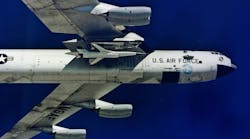Many of today’s weapons systems and platforms are legacy systems that were designed and manufactured decades ago, and now require expensive repair or replacement parts—and those parts are unavailable.
“Take the B-52 bomber, for instance,” says Brig. Gen. Allan E. Day, commander of Defense Logistics Agency Aviation. “It’s a legacy system that's going to be on the flight line for a long time," Day’s organization, DLA Aviation, supports more than 1,800 weapon systems and is the DoD’s manager for more than 1.1 million national stock number items, industrial retail supply, and depot-level repairable acquisitions. He hopes 3D printing will be a game changer for logistics and keeping legacy systems operational and economically viable.
At the U.S. Army Research Laboratory at Aberdeen Proving Ground, the general was recently shown a demonstration of cold spray, a material-deposition process in which metal or metal-ceramic mixtures of powders are sprayed to form a coating or even a freestanding structure. The particles embed on impact, forming strong bonds with the surface. The process has already saved millions of defense dollars by enabling previously unusable worn parts to be reconditioned and reused.
“Additive manufacturing will give soldiers and sailors the ability to make parts themselves right then and there,” Day explains. “They won’t have to outsource to get these parts. That means they’ll get the parts sooner.” He says he hopes future processes will result in parts that are “just as reliable” as traditionally manufactured parts.
“We conduct the fundamental interdisciplinary research in materials and manufacturing science that will ensure rapid and affordable development of materials—from discovery to delivery—critical to the Army of the future,” added Jeff Zabinski, director of ARL’s Weapons and Materials Research Directorate. “Our goal is to create a science base that is the foundation for making in-line certified parts that will reduce logistics burden and enable rapid response to unknown threats.”


